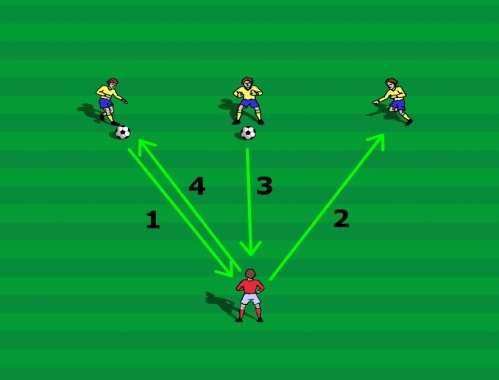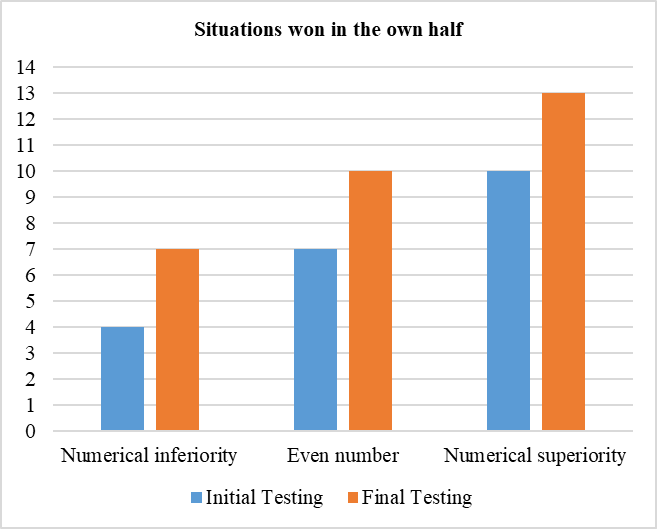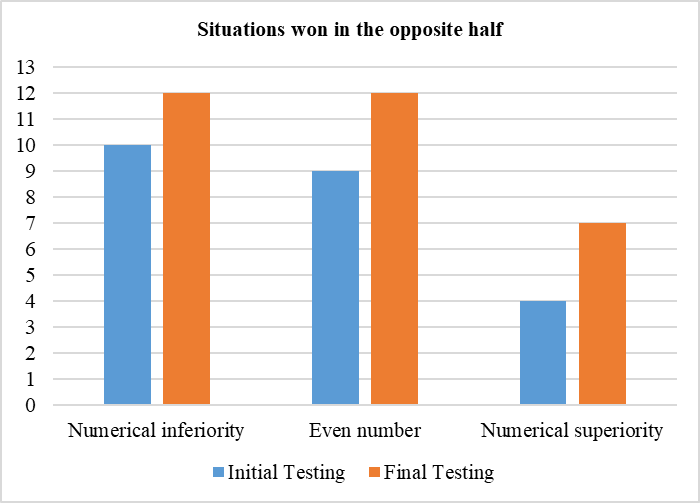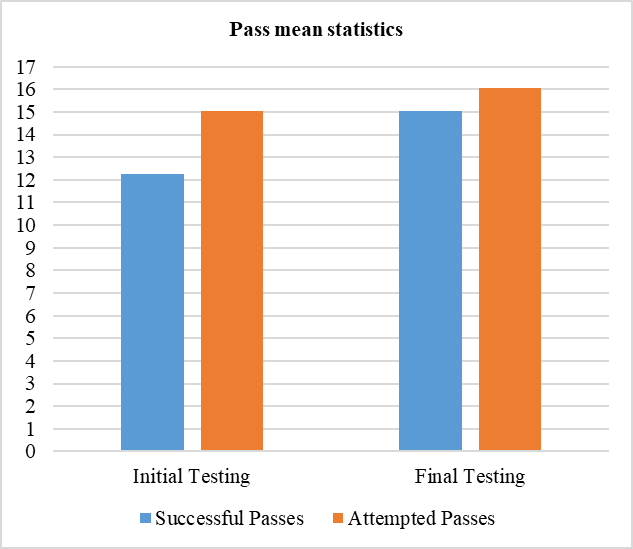Abstract
The increased level of the distributed and focused attention, as well as the ability to make the right decisions under limited time and space conditions, is an essential skill of the contemporary football player and provides an advantage over the opponents. These features must be therefore educated starting with the junior period, in order to contribute to the development of a complete football player. This study is observatory; its aim is to improve the percentage of successful individual decisions to continue the game actions, both in training and especially in game conditions. This was accomplished through technical and tactical individual actions with and without a ball. The hereby research referred to the “C” juniors, aged 12-14 years, carried out on an experimental group of 20 players belonging to the Children and Junior Centre of the CSM Ceahlaul Piatra-Neamt Sports Club. The subjects trained 3 times a week, following a pre-established training programme. After the final testing and the interpretation of the initial and final results, there was a significant improvement in the percentage of the decision-making that led to the continuation of the game actions or to goal scoring, which has confirmed the hypothesis that making the right decisions under pressure (limited time and space) directly contributes to a greater percentage of the scored goals and won matches.
Keywords: Focusdecisiontactical actionadversity
Introduction
Performance football has been constantly evolving from a tactical and technical point of view, being a highly combined game which has as main features the following: a high number of passes, combinations between two or more teammates, and a tactical level which is getting higher and higher. The combinations between two, three or more players represent the main way to take by surprise the opponents, creating hazardous actions and scoring goals. At the same time, the speed of the game has also increased, meaning that the time for the tactical decision-making by each player has diminished. For this reason, besides a high percentage of technical skills such as passes, shots, head shots, an individual tactical thinking is necessary to be as developed as possible in order to improve the decision-making factor which can solve the game situations as efficiently as possible. According to Giacomini (2009), tactical skills reflect the ability of a player to use his psychic and physical skills, his technical and tactical abilities in various game situations to solve individual and collective tactical tasks, things that give player a range of choice of one behaviour rather than another on the pitch.
The training goals originated ever since the junior level require the “assimilation of the technical skills and the tactical actions specific to the practice of different branches of sport” (Raţă, 2008). In other words, a trained tactical thinking can lead to a more developed technical-tactical factor, thus improving the individual and team performances. Regarding tactics, this must be “rational, determined by the tactical thinking” and “the efficiency of the individual and collective actions is triggered by the selective and creative contribution of reasoning” (Ciolcă, 2006, p. 98).
In football, tactics is closely related to many other game features, such as the value of the general and specific motor capacity, the individual technique level, the theoretical knowledge level, or the player’s psychological profile. Specialists now think that football performance depends mostly on visualisation and the ability to make the right decision, as they are two aspects that need to be trained more than ever in order to improve the performances in football. Ericsson (1996) claimed that “game intelligence develops as a result of the perceptual and cognitive adaptations that arise following many years of deliberate, purposeful practice in the sport”. In other words, a superior game intelligence leads to a superior decision-making skill, which gives player an advantage on the pitch.
Therefore, we consider that a tactical thinking and the ability to make decisions when lacking space and time can and must be trained from an early age, in order to prepare the player for the intensive and highly tactical games which will take place in the senior teams. As many other theoreticians, Wein (2004) considers that current football requires the mastery of four mechanisms: perception, understanding, decision-making and execution. This can be done by implementing some exercises which also have tactical characteristics and give players the opportunity to assess their situation (perception and understanding) and then to find the optimal solution on their own, namely to make the right decision. Using this training method, we believe that we can improve the decision-making factor and implicitly increase the individual and team performance.
Problem Statement
This research has got as a starting point the hypothesis according to which the improvement of the decision-making factor, which refers to making the right decisions to continue the action under pressure (limited time and space), directly contributes to a higher percentage of opportunities created and scored goals and depends directly on the player’s tactical thinking level.
The research was carried out on a “C” Junior group of 20 players aged 12-14 years, belonging to the Children and Junior Centre of the CSM Ceahlaul Piatra-Neamt Sports Club. The subjects trained 3 times a week, following a pre-set training programme.
The research was conducted over a period of five months, during which the players had 40 action systems included in their training programme, designed to stimulate the tactical thinking and to improve the decision-making capacity when lacking space and time. These action systems aimed at a number of 4 technical-tactical aspects of the football game: individual technique, movement games, technical-tactical situations and adversity situations (1 vs. 1, 2 vs. 1, 2 vs. 2, 3 vs. 2, 4 vs. 2, 1 vs 2, 2 vs 3). The action systems were used in two of the three training sessions during a week.
The evaluation of the 20 subjects was made at the beginning of the study, in October 2017, and at the end of the research period, in March 2018, in two ways: the first consisted of two friendly games (one at the initial testing and one at the final testing) against a team with players of the same age group belonging to LPS Piatra-Neamt. The second entailed the use of ball passing and catching exercise to and from the teammates within a predefined time (30 seconds). More precisely, the players were divided into groups of 4. One of them received and passed the ball to one of the other 3 players who did not have any ball (2 of the 3 players have a ball), being placed at a 10-metre distance away (Figure
As rules to be followed, the practising player had to keep his head up and look ahead, inform himself and plan his next move, take the ball in the direction of the next pass, and pass the ball with the width of the foot after a maximum of 2 touches of the ball.

Research Questions
By analysing the theoreticians’ views regarding the implementation of the tactical thinking during training, in order to optimise the tactical decision-making skill during the match, at the “C” junior level, the following questions have arisen:
Are the tactical thinking and the ability to make the optimal decision under limited space and time important in football nowadays?
Is there a connection between the ability to make optimal decisions under limited space and time in various game situations and the number of opportunities and also the result of the game?
Is the technical-tactical level shown by players in official games influenced by the tactical thinking implementation?
Purpose of the Study
The hereby research aims to emphasise the importance of using the tactical exercises that stimulate tactical thinking in the football training process, in order to improve the decision-making factor and the performance during the match.
Research Methods
In order to accomplish this research, we used the following methods: the bibliographic study, the statistical-mathematical method, the experimental method and the observation method.
Findings
The results of the initial testing (IT) and final testing (FT), as well as their interpretation, can be found in Tables
Following the verification matches, a significant increase in the total number of goal attempts to the opponent was found, from 12 to 23, being almost double. In addition, the number of shots on goal got a nearly triple increase, from 5 to 14. All these mean both an increased efficiency of the attack actions and an increased ability to solve game actions optimally and get a better score.
Thus, related to the actions performed in the own half of the field, in the numerical inferiority situations, there was an increase of 75% of the duels for the ball won in the final testing, from 4 to 7 won duels, which is also the total number of situations of numerical inferiority in the final testing, i.e. a 100% percentage. Regarding the even number situations, there was a 43% increase of the won situations compared to the initial testing, from 7 to 10, which is also the total of both initial testing and final testing. In terms of the numerical superiority situations, the number of the won situations in the final testing increased by 3, representing a 30% higher than in the initial testing, and 93% of the total situations of the game.

This indicates an improvement of the game on the defensive segment, the players being more successful in duelling with the opponents, treating the game situations more calmly and making the optimal decisions to remove the danger or continue the actions without any threat at their own goal.
Regarding the actions performed in the opponent’s half, the numerical inferiority situations were the most common, the percentage of the won situations improving by 20%, being 12 in the final testing compared to 10 in the initial testing representing a 75% of the number of total situations of the match, i.e. 16.
In the even number situations, the percentage of the won situations improved by 33.3% in the final testing, with 3 more won situations than in the initial testing, the number being 12 and representing 85.7% of the 14 situations recorded during the match Finally, in the numerical superiority situations in the opponent’s half, there were 3 duels won more in the second match than in the first one, which represents a 75% progress and also the total number of situations.

The results indicate that there was a game improvement also on the offensive segment, the attack actions being more penetrating, having a better fluency and with a higher hazardous degree. In addition, based on the number of the total attempts recorded, we can see that the players were able to find the optimal solutions both in the numerical inferiority situations and in the even number or numerical superiority situations.
Regarding the technical-tactical ball catching and passing exercise within a predefined time, there was also an improvement in performance at the final testing, both at the mean of the successful passes and the mean of the total attempts performed. To be more precise, at the initial testing, the mean of the successful passes was 12.25 in 30 seconds out of a mean of 15.05 passes attempted in the same length of time, the most common value of the successful passes being 12. On the other hand however, in the final testing, the mean of the successful passes was 15.05 in 30 seconds, out of a mean of 16.6 passes attempted, the most common value of the successful passes being 15.

This means an obvious progress between the two kinds of testing, but also for each testing, based on the number of successful passes out of the number of total passes attempted. Thus, in the final testing, the players reached 3 more passes than in the initial testing, but the average number of successful passes was also very close to the total number of the total passes attempted, indicating a higher degree of focus and stronger tactical thinking in most players.
Conclusions
After analysing and interpreting the results, we have concluded that the decision-making factor can be improved in the 12-14-year-old football players through the technical-tactical actions manifested by certain action systems within the training process. By constant practice of these action systems, players managed to improve their overall performance and also to make the right decisions within limited space and time. The team performance also improved the team play, as both the results of friendly matches (2-2 in the first match and 5-1 in the second match) and the number of total attempts (12 in the first game and 23 in the second game) revealed. Therefore, it has been shown that there is a connection between the decision-making factor and the number of opportunities in a game/match. It has also been demonstrated that the players’ technical and tactical level is directly dependent on their tactical thinking, being improved if the tactical thinking is constantly trained.
Following the application of the five-month operational programme, there were major changes in the players’ ability to make the optimal decision within limited space and time, in other words, the tactical thinking improved and, at the same time, the visualisation during the tactical actions, which was confirmed by the greater number of opportunities in the second friendly game.
By applying the research methods and performing the initial and final testing and according to the data analysis, the hypothesis according to which the improvement of the decision-making factor materialised by making the appropriate decisions to continue the action under pressure (limited time and space) directly contributes to a greater percentage of scored goals and is directly dependent on the player’s tactical thinking level, has been confirmed.
References
- Ciolcă, S. (2006). Tehnica și tactica jocului de fotbal. București: Editura Fundației România de Mâine.
- Ericsson, K. A. (1996). (Ed.). The road to excellence. New Jersey: Lawrence Erlbaum Associates.
- Giacomini, M. (2009). Ghid tehnic pentru şcolile de fotbal (Ed. a III-a). București: FRF.
- Raţă, G. (2008). Educația fizică și metodica predării ei. Bacău: PIM.
- Wein, H. (2004). Developing game intelligence in football. Spring City: Reedswain.
Copyright information

This work is licensed under a Creative Commons Attribution-NonCommercial-NoDerivatives 4.0 International License.
About this article
Publication Date
16 February 2019
Article Doi
eBook ISBN
978-1-80296-054-9
Publisher
Future Academy
Volume
55
Print ISBN (optional)
-
Edition Number
1st Edition
Pages
1-752
Subjects
Sports, sport science, physical education
Cite this article as:
Felegeanu, C., & Rață, G. (2019). Improving The Decision-Making Factor Through Technical And Tactical Actions In Football. In V. Grigore, M. Stănescu, M. Stoicescu, & L. Popescu (Eds.), Education and Sports Science in the 21st Century, vol 55. European Proceedings of Social and Behavioural Sciences (pp. 604-611). Future Academy. https://doi.org/10.15405/epsbs.2019.02.75
